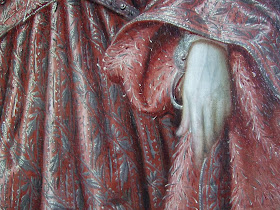Portrait of a doomed Prince
This gentleman gazes down at us from the wall of the Council Room in the Old Schools building in central Cambridge. He is dressed in splendid Elizabethan clothing, an early seventeenth-century lace collar, and silver shoes with elaborate rosettes.

The predominant colours of the portrait are pink, silver and a rich billiards-table green. The young man wears matching pink hose, and the pompoms on his shoes echo the decorations of his fabulous Stetson-type hat. The detail of the costume is gorgeous: it is of a shiny satiny rose-coloured material, embroidered in silver thread. The veins stand out delicately in pale-blue on the back of the hand.




The man wears the insignia of the Order of the Garter: a velvet garter around his leg and the so-called Great George, hanging from his collar (an enameled medallion showing St George on his horse).
Note the draped curtains that don't appear to be attached to any support. This device is common in portraiture and serves to glorify the sitter. The German art historian Aby Warburg called this kind of motif a Pathosformel: a formula for pathos and majesty.

But the best
thing about the picture is the piece of paper pinned to the curtain with a nail. The nail casts a tiny shadow. It reminds me of the nail in George Braques's cubist picture in Tate Modern.
How good is your Latin? If it's a little rusty, you can find the full translation of the inscription on wikipedia.

The young man is the Prince of Wales, Charles Stuart, who became King Charles I in 1625 and was famously beheaded in 1649. The portrait was commissioned by the University of Cambridge to commemorate Charles's visit to Cambridge on 6-8 March 1613 (aged thirteen).
The picture is by Robert Peake the Elder who made something of a speciality of painting royal portraits.
The National Portrait Gallery in London has a very similar-looking engraving of Charles I. It also sports the costume, the Order, the curtain and the fantastic domed hat.
 |
| King Charles I, by Renold or Reginold Elstrack (Elstracke), line engraving, early 17th century , NPG D25733 © National Portrait Gallery, London (licensed via Creative Commons) |
What and where
Portrait of Charles, Prince of Wales by Robert Peake the Elder, 1613, oil on canvas, Council Room, Old Schools, Senate House Passage, Cambridge, UK

No comments:
Post a Comment